
The Entrance Hall was the first car built by Henry Ford and current models of the Lincoln-Zephyr, Mercury and Ford V-8. The "Road of Tomorrow" was a ride which took the visitor through the other areas while viewing the exhibits and murals depicting the construction of the highways of tomorrow.
Ford's display was divided into four main sections – the Entrance Hall, the Industrial Hall, the Garden Court and the "Road of Tomorrow."
The stainless steel Sculpture of Mercury by Robert Foster floated over the main entrance to the "Ford Exposition". Foster designed the U.S. Petroleum Industry stamp (Scott 1134) of 1959.
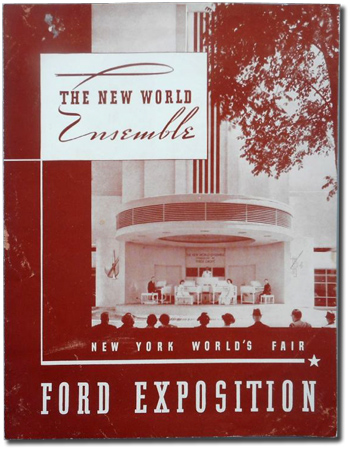
Image courtesy of Andy Kaufmann
"The New World Ensemble", "Ford Exposition", "New York World's Fair". Inside is "The Story of the New World Ensemble" and a write up on "Ferde Grofe" the conductor. The back cover has advertisements for 2 Hammond organs. Size: Closed: 6 7/8" wide by 9" high. Opens to 13 3/4" wide.
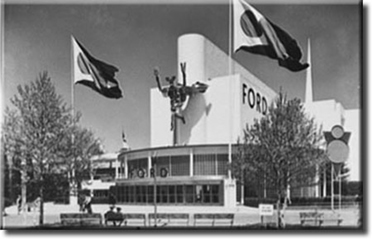
Gottscho-Schleisner Collection (Library of Congress)
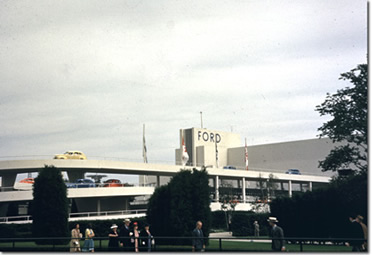
Historical Society - wf-014r
Read David Cope's Perisphere Ponderings about Ford Motor Corp.

Henry Ford insisted the company’s exhibits by “instructive in nature.” To that end, the Post editors heralded the exhibit as “costly, elaborate, American through and through.”
Henry Ford informed reporters he saw a horse-drawn fire engine with a gasoline motor pumping water at the 1893 Columbian Exposition and this vehicle started his mind to work.
Henry and Edsel Ford leased an estate on Manhasset Bay for the summer to be close to the fairgrounds.
Ford, a teetotaler, would not allow alcohol at the company’s San Francisco exhibit but gave in to executive pleadings in New York.
The entrance hall displayed Henry Ford’s first engine, built in 1893, his first car built in 1896 and his first two-cylinder Model A from 1903. However, within a month and a half after the Fair’s opening, the pavilion’s managers completely redesigned the entrance hall following complaints by the company’s president, Edsel Ford. The new designed allowed facilitated a greater view of the fairgrounds. The curtains were made of one and two-thirds miles of knitted cellophane and 800 yards of Chinese silk, weighing 662 ½ pounds. The floors were covered with a combination of rubber and cork for more comfortable walking.
One the extensive tract of land the pavilion inhabited, an acre tract was set aside to continuously demonstrate Ford’s wonder tractor. The four-cylinder vehicle could go between 3 mph up to 12 mph and cost $585. Edsel Ford often drove it for fun.
Ford provided a special twenty-four hour care clinic with eight nurses and a special porcelain foot basin for foot-blistered visitors.
The Ford pavilion devoted one-third of its land area to lawns and gardens, signaling a new era in industrial planting and beautification. The Exposition Garden and the area surrounding Isamu Noguchi’s Chassis Fountain, which was encircled overhead by “The Road of Tomorrow,” contained 46,650 blue and white pansies, to go along with Teague’s exterior color scheme. As the spring progressed, gardeners replaced the pansies with 21,620 blue and white verbenas. Pools containing 75,000 gallons of water were strategically placed throughout the pavilion’s grounds.
People listening to the free concerts of the Novachord Orchestra in the pavilion’s garden discovered their clothes quickly became marked with a resin used to paint the benches.
On June 16, the Ford pavilion celebrated the thirty-sixth anniversary of the founding of the company. Henry Ford, his wife, his son Edsel and 6,000 company executives participated in the celebration. The ceremonies were held near the stainless-steel statue of Mercury at the pavilion’s entrance in weather approaching 100 degrees.
The highlight of the day was the arrival of Ford’s 27,000,000 automobile. Made at the company’s Richmond CA facility, Jack Doyle and Jimmy Rooney drove it across country from the San Francisco fair to “The World of Tomorrow.” The car began its return trip to the west coast on June 22.
When the automobile entered the fairgrounds at 1:57 P.M., the National Cash exhibit displayed 27,000,000. This shocked many onlookers as the register normally recorded the daily attendance and no one could believe that many people were on the fairgrounds.
Henry spoke briefly at the ceremonies stating: “They tell me that I once said that ‘history is bunk.’ Not this history. Here is the real story of mankind – it makes wars and politics look cheap.”
His body guard, Deputy Sheriff Thomas Ward, did have a moment of consternation when the aged industrialist suddenly broke ranks to greet one of the pavilion’s employees, shaking the startled man’s hand.


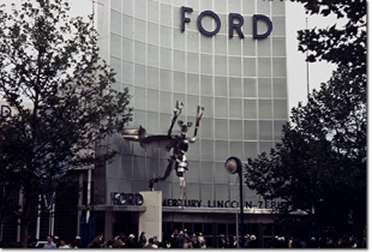
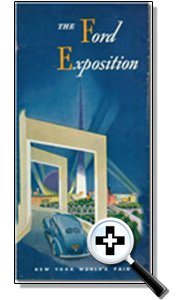
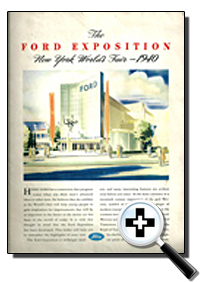
- Return to:
- Transportation

